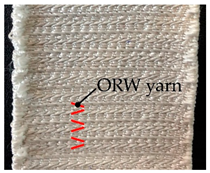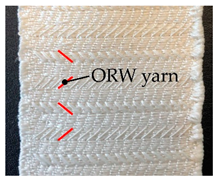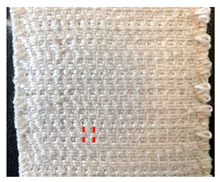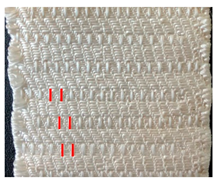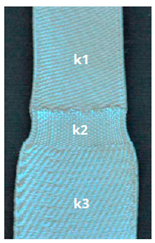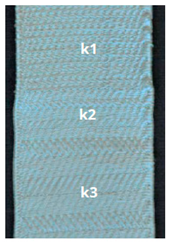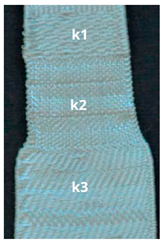Abstract
Tendons and ligaments are complex tissues that are necessary for human movement. Injuries occur very commonly and treatment quite often requires implants. Such implants must be adapted to the biological and structural composition of human tendons and ligaments. Thus, the objective is to realize graded, biomimetic tendon and ligament implants that are long-term resorbable. First, basic woven fabrics are fabricated from biocompatible silk fibroin yarns. Starting from the basic fabrics, gradient fabrics, with three different weave zones, are then developed and produced. In addition, fabrics with variable width and lateral warp yarn offset are fabricated on the basis of open reed weaving (ORW) technology on a modified shuttle narrow weaving loom. Meso-scale finite element models are developed in order to support the design of the gradient weaves. First, TexGen software is used to create a close to reality fabric geometry. Models are then converted into beam element models using a Python script. Results of real and virtual tensile tests show a clear relationship between the crimp of the warp yarns in the fabric structures and the resulting elongations. The additional ORW yarn system influences the stiffness. The tensile behavior of experiments and simulation agree very well, so the models are suitable for further development of woven implants.
1. Introduction
1.1. General Considerations
Tendons and ligaments are complex tissues that are necessary for movement of the human body. Ligaments connect two bones, and serve to guide and support joints, while tendons realize the transmission of forces between soft muscles and hard bones. Injuries occur very commonly, and usually due to chronic abrasion or trauma, e.g., in sports accidents. The gold standard for the treatment of such defects is the use of the patient’s own tissue, e.g., from the back muscle for shoulder tendons or from the thigh for the anterior cruciate ligament. However, autologous material is only available in limited quantities and harvesting is associated with an increased risk of complications (donor morbidity). Alternatives to autologous material are biological or synthetic implants, which, however, still have significant deficits. Thus, from a medical and economic point of view, there is a need to develop novel biomimetic (adapted to biological and structural properties of human tendons and ligaments) and long-term resorbable implants to cure defects.
Tendons and ligaments are primarily composed of collagen fibers embedded in an extracellular matrix. The fiber arrangement is subject to a complex hierarchical principle. They not only run parallel to the longitudinal axis, but also are diagonal as well as undulating and intersecting. The arrangement varies depending on the position. Thus, they form spiral-like, interwoven structures []. The undulation of fibers protects tendons and ligaments from injury, as the fibers first align themselves under load (structural elongation) before rupture because of excessive material stretching. The nonlinear deformation behavior of tendons and ligaments is realized by complex, graded structural zones. Deformation occurs initially by alignment of undulated collagen fibers and leads to complete failure through material stretching and initial fibril rupture. The tendon and ligament tissue first transitions into cartilage tissue and then into bone tissue. In tendons, a transition zone also forms between the tendon and muscle. In the three or five different tissue zones, different cell types and matrix compositions are found, which exhibit different stiffness and deformation behavior. It follows that implants must represent these different zones to ensure appropriate cell colonization and, thus, restoration of the ligament or tendon.
The use of degummed silk (silk fibroin) improves mechanical properties, biocompatibility, and long-term resorbability, compared to currently used resorbable polymers [,,,,]. Furthermore, the formation of toxic degradation products is avoided. Silk fibroin is a natural protein with high bioactivity and good biocompatibility. It supports or promotes adhesion, proliferation, growth and differentiation of cells, which eventually lead to tissue regeneration [,,,,,,,]. Silk fibroin fibers have a strength of about 0.5 GPa and a breaking strain of around 15% []. Compared to other resorbable materials, such as collagen and poly-L-lactide acid (PLLA), silk fibroin fibers are thus highly resilient: they exhibit a strength more than three times higher than PLLA and 67 times higher than collagen []. Therefore, silk fibroin yarn is especially predestined for the reconstruction of tendons and ligaments in terms of structural mechanics.
1.2. Textile Materials for Use as Tendon or Ligament Implants
Textile technology is especially suited to fabricate graded and biomimetic tendon and ligament implants. Various technologies were investigated for that purpose: braiding [,,,,,,], knitting [,,], weaving [,,,], and embroidery [,].
Using braiding, adjustment of fabric properties is mainly limited to the variation of the braiding angle. While tendons and ligaments exhibit relatively small dimensions (up to 10 cm), structural adaptation to natural requirements of tendons and ligaments is, thus, only possible to a limited extent within the process. A change in geometry (e.g., from the ligamentous bone-tendon insertion to the round tendon center) requires special machines that can switch between flat and circular braids. The implementation of graded stiffness zones is also challenging, as stiffness differences homogenize in regular braids with recurrent cyclic loading.
Gereke et al. [] have presented a possible range for tailoring the mechanical properties of braided ligament replacements by a variation of the braiding process parameters, together with an FEM (finite element method) model of the braiding process. They varied the braiding angle by applying different draw-off forces in the braiding process, which influenced the tensile properties of the braided structure.
Knitted fabrics for tendon/ligament implants have been prepared from silk fibroin [], Poly(Lactic-co-Glycolic Acid) (PLGA) [,] and Poly-ε-Caprolactone (PCL) []. Even though cell reaction was positive, mechanical strength of native tendon/ligament could not be achieved, due to the fact that its textile structure and deformation behavior could not be reproduced. The commercially used knitted product Artelon® (Artelon, Marietta, GA, USA) is manufactured from fibers of polycaprolactone-based polyurethane urea (PUUR) [,]. However, it does not exhibit graded stiffness and, thus, does not support locally adapted cell differentiation.
Stitching of tendon and ligament replacements has also been investigated for the anterior cruciate ligament using absorbable lactic acid-based materials [,]. However, machine parameters, such as stitch length and needle diameter, limit the formation of graded features.
Woven implants are commercially available. The woven fabric X-Repair™ (Synthasome Inc., Del Mar, CA, USA) is manufactured from PLLA fibers and, thus, bears the risk of over-acidification of the defect site []. Due to the highly dense weave, there is only little space available for the formation of tendon cells from collagen fibers and supporting extracellular matrix. Another commercial product, Biofiber™ (Tornier Inc., Edina, MN, USA), is an open-pored leno weave from the degradable polymer prolyl 4-hydroxylase (P4HB) []. It is constructed from several textile layers that are sewn together []. It provides only a constant deformation behavior over the length, which means that the requirements for a biomimetic implant are not achieved.
The deformation behavior of a woven fabric is a result of fiber material properties and the weave pattern used. Selectively combining different weave patterns within one fabric enables locally different deformation behavior. This effect has been used to date to adjust the drape behavior of fabrics for composite reinforcements in a targeted manner [,]. The use of open reed weaving (ORW) technology (broad weaving technology) and variable-width reed (ribbon weaving technology), in combination with multilayer woven structures, represent promising approaches for realization of fabrics with locally adjustable deformation behavior (structural mechanical gradients), varying fabric width and porosity over the length (geometric gradients) for biomimetic tendons and ligaments.
A simulation approach for the generation of a unit cell has proven to be especially useful, since it results in a high accuracy in representation of yarn cross-sections and contact areas compared to a moderate computation time [,,]. Finite elements, known as digital elements, are particularly suitable for modeling textile structures made of multifilament yarns [,,,,]. In this micro-scale approach, the filaments are discretized by chains of truss or beam elements connected by frictionless links at their nodes. The only mechanical property of the yarn is the tensile modulus in the fiber direction.
The objective is to realize the basis for graded, biomimetic and long-term resorbable tendon and ligament implants, based on biocompatible silk fibroin yarns. Implant design should approximate native anatomical shape and biomechanical behavior of tendons or ligaments through structural mechanical and geometric gradients to allow rapid healing and remodeling by cells. For development of tendon and ligament structures with variable texture and porosity over their lengths, varying deformation properties and high strength, weaving technology, in particular, offers excellent potential.
2. Materials and Methods
2.1. Material
Degummed silk fibroin yarns (D’orica s.r.l., Nove, Italy) with a linear density of 33 tex were used for the studies. The silk is in the form of a twisted yarn with circular cross-section. Yarns exhibit nonlinear mechanical behavior in tension with a Young’s modulus of 12.0 GPa (coefficient of variation, CoV: 9.2%) and a maximum stress of 43.3 cN/tex (CoV: 2.6%). These values refer to 50 yarn tensile tests, according to DIN EN ISO 2062 []. Tensile test results of the yarns are displayed in Figure 1.
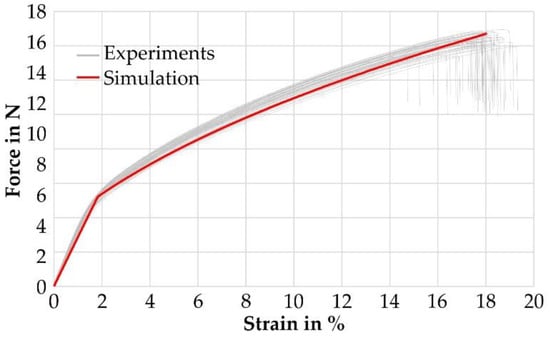
Figure 1.
Results of tensile tests of 33 tex silk fibroin yarns and material model for simulation (material model is described in Section 2.4).
2.2. Weaving
Multilayer woven fabrics with different stiffness properties are created by incorporating warp yarns differently into the fabric structures. Three different basic weave patterns were selected (compare Table 1). These were two layer-to-layer fabrics of plain and satin weave, respectively, and one angle-through-thickness fabric. Warp yarn density was varied between 75 cm−1 and 150 cm−1, while weft yarn density was constant with 50 cm−1. The fabric samples of the individual weave patterns were produced on a shuttle-loom-weaving machine with Jacquard unit (Mageba Textilmaschinen GmbH & Co. KG, Bernkastel-Kues, Germany).

Table 1.
Data of multilayer weaves.
Furthermore, open reed weaves (ORWs) were developed. For this purpose, weaves with different lateral offsets in the warp direction were designed in such a way that different angles of the ORW yarns were obtained. Table 2 shows the configurations of two ORW fabrics, denoted ORW1 and ORW2. As a basic structure, angle-through-thickness weave was used. The difference between both was the ORW yarn offset in the weft direction, which was two weft rows in ORW1 and six weft rows in ORW2. This resulted in ORW angles of 26.6° and 56.3°, respectively. In order to achieve a homogeneous elongation across the fabric width without the edge yarns falling out, lateral offset was selected over four warp yarn rows. To determine the influence of the additional ORW yarn system, the angle-through-thickness weave without such ORW yarns, presented in Table 1, served as a reference.

Table 2.
Overview of open reed weaves.
For ligament and tendon implants, the structures have to be graded, i.e., they have to have zones with different stiffness ranges. Three of such gradient structures, termed GW1–3, were developed and fabricated (Table 3). Each of them had three different weaving zones within one fabric. The weave patterns to create the zones were selected based on stiffness and referred to as k1, k2 and k3. The first gradient weave (GW1) was a multilayer weave with geometrical and structure mechanical gradient. Varying width within different zones, between 24 to 30 mm, accounted for the geometric gradient. The structure mechanical gradient was achieved by varying the weave pattern in the different zones. Fabric GW2 was an ORW weave with constant width and structure mechanical gradient, which was induced by varying ORW yarn offset in the weft direction. ORW yarn was moved 2, 6 and 12 weft rows, respectively. The third fabric, GW3, was an ORW weave with structure mechanical gradient and additional geometrical gradient, i.e., width of the three zones varied between 24 to 30 mm. Structure mechanical gradient was induced by varying ORW yarn offset similar to GW2.

Table 3.
Developed woven structures with geometrical and/or structure mechanical gradient.
For production of ORW fabrics with lateral warp yarn offset and variable width, a shuttle loom narrow weaving machine was modified. The principle of open reed weaving, known for its broad weaving technique, was adapted to a narrow weaving technique. This required designing an additional ORW device, which was located between a weft insertion zone and shed-forming device and envisaged inserting additional warp yarns into the woven structures by a linear system. Temporary dipping of needles into the shed and laterally displacing the yarns by means of an open reed achieved this (Figure 2). A Y-reed open at the top was used here. To increase process reliability and to ensure collision-free operation, an additional reed for sorting warp yarns was installed directly behind the shedding device. Thanks to the swiveling design of the linear system, the ORW needles could, thus, be moved in front of the reed in the rear shed and dipped into the required warp aisle.
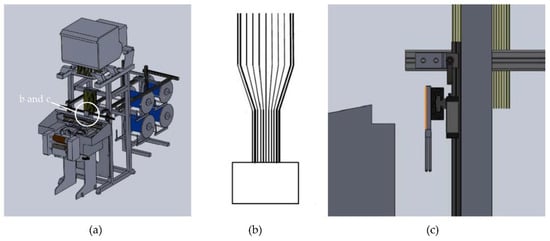
Figure 2.
Developed additional ORW device: (a) integration into the weaving loom, (b) gantry system with ORW needles, (c) inserted open weaving reed with variable fabric width.
In addition, solutions for effective fabric guidance, in particular variable fabric spreading, were developed and implemented. To meet the required fabric widths, the fabric was kept wide with laterally inserted monofilaments. These monofilaments were pulled out of the fabric edge during the finishing process. This had the advantage that, on the one hand, the width of the temple was variably adapted to the reed width and, on the other hand, any temple rollers did not damage the fabric.
2.3. Testing
To determine the different structural strains along the fabric length, tensile tests were carried out according to DIN ISO 13,934 [] on a Zwick ZMART.PRO (ZwickRoell GmbH & Co. KG, Ulm, Germany) testing machine using a camera system (Figure 3). To record the different strains, specimens were patterned (point clouds) and subsequently evaluated using GOM Correlate (Carl Zeiss GOM Metrology GmbH, Braunschweig, Germany) image processing software.
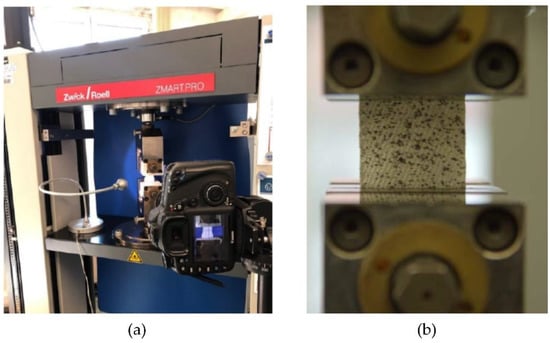
Figure 3.
(a) Measuring setup for determining stress-strain behavior of fabrics and (b) clamped test specimen with speckle pattern.
2.4. Modelling
The basic weaves were transferred to numerical meso-scale models in LS-DYNA and subjected to virtual mechanical tests in order to predict mechanical tensile behavior. TexGen software [] was used to create a close to reality fabric geometry (Figure 4a). Fabrics were modelled with unit cell dimensions on the meso-scale, i.e., individual yarns were modelled. The generated fabric models were then converted into beam elements using a Python script, thus creating an FEM model for LS-DYNA (Figure 4b). The bending limp characteristic of silk yarn was taken into account by applying the digital element approach [,], in which the bending stiffness of the model yarn is neglected. The macro-scale fabric was assumed to consist of periodic multiples of the generated models. Therefore, the node pairs on opposite faces belonging to the same yarn were coupled using periodic boundary conditions to ensure the same displacement of each node pair.
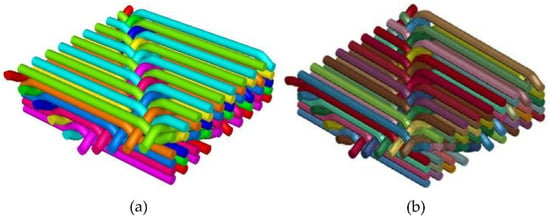
Figure 4.
Exemplary model generation for angle-through-thickness weave: (a) TexGen model, (b) beam element model in LS-DYNA.
To form models of gradient fabrics, unit cells of base fabrics were combined. Since different positions of the warp yarns can occur at the end of a weave zone in the weft position, additional transition weave zones were created to ensure a correct yarn course. To reduce the numerical effort, only a quarter of the gradient fabric was simulated by exploiting geometry symmetries, ensuring node displacements only on the corresponding symmetry plane. Accordingly, boundary conditions were added to the symmetry planes. Figure 5 shows the model for fabric GW1.
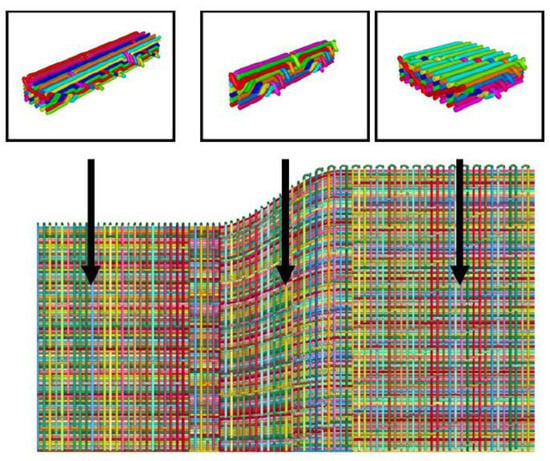
Figure 5.
Model of fabric GW1 with gradient structure (one-fourth model), from left to right: layer-to-layer satin weave, layer-to-layer plain weave, angle-through-thickness weave.
A suitable material model for silk fibroin yarn was developed based on tensile tests (see Section 2.1). An elasto-plastic material with isotropic hardening was used. The yield stress, σy, is a function of plastic strain as follows:
Herein is the elastic strain to yield and the effective plastic strain (logarithmic). A strength coefficient and a hardening exponent are termed a and b, respectively. The elastic strain at yield is
with E as Young’s modulus. Figure 1 shows the material model along with experimental yarn tension tests.
For evaluating the fabric models, they were virtually loaded. Fabric deformation under load was investigated in the warp direction using corresponding boundary conditions.
3. Results and Discussion
3.1. Testing
Tensile test results of multilayer weaves are presented in Figure 6a. The relationship between crimp of warp yarns in the fabric structures and resulting elongations can be clearly observed. Stiffness was highest for layer-to-layer satin fabric, as it had the least crimp. The evaluation of the measurement results for ORW fabrics (Figure 6b) shows that the additional ORW yarn system influenced the stiffness. The ORW yarns additionally compact fabrics with a lower number of weft rows between the offset, resulting in a stiffer structure.
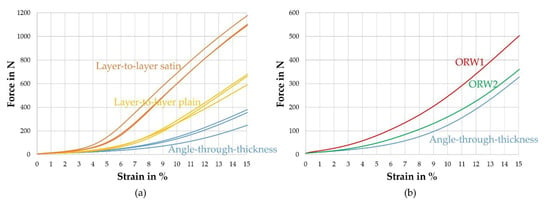
Figure 6.
Force-strain behavior in the range up to 15% elongation of (a) multilayer weaves and (b) ORW weaves (mean) as measured from tensile tests.
The strain in the individual zones of the gradient weave structures was determined using image evaluation software GOM to correlate displacements between applied paint dots. The optical evaluation of gradient fabrics during tensile tests showed that individual zones exhibited different strains (Figure 7).

Figure 7.
Exemplary images of DIC measurements during tensile testing of (a) GW1, (b) GW2, and (c) GW3.
The result for GW1 (compare Figure 7a) showed significantly higher strain in the angle-through-thickness zone (k3). Strain was 46% higher compared to the layer-to-layer plain weave zone (k2) and 47% higher compared to the layer-to-layer satin weave zone (k1). It should be noted that due to reduction in fabric width, higher warp yarn tensions were present and, thus, the elongation of the plain weave was lower than characteristic values from individual tensile tests.
The stretched ORW yarns on the backside of the fabric in GW2 caused inhomogeneous elongation behavior, as displayed in Figure 7b. The elongations in the individual zones differed. In the weave zone with lower offset of the ORW yarns (two weft rows, k1), stiffness was 15% higher compared to an offset of six weft rows (k2) and 37% higher compared to an offset of 12 weft rows (k3).
The optical evaluation of GW3 (Figure 7c) shows similar results as those of the tensile tests for GW2. The additional ORW yarns led to inhomogeneous elongations along the warp direction due to the stretched yarn layers on the backside of the fabric. The elongation ranges themselves differed only slightly from the results of GW1. Thus, in the zone of the angle-through-thickness weave (k3), there was a 45% higher elongation compared to the zone of the layer-to-layer plain weave (k2) and a 49% higher elongation compared to the layer-to-layer satin weave (k1). Again, the zones of layer-to-layer plain and satin weaves were close to each other.
3.2. Modelling
Geometric model validation is performed by comparing unit cell geometry with micrographs of the fabrics (compare Figure 8). A good representation of the real geometry was found for the modelling approach.
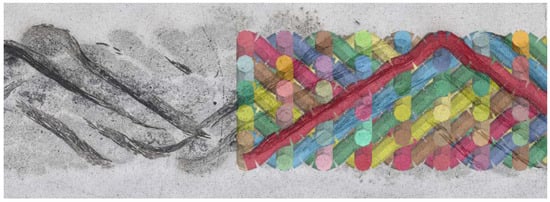
Figure 8.
Comparison of a model and micrograph of the corresponding fabric (angle-through-thickness).
Figure 9 compares the force-strain behavior of experimental and numerical tensile tests. The simulation results were scaled by the ratio between the number of warp yarns in the simulation model and the number of warp yarns in the tested fabric. The structure-mechanical behavior of the fabrics was nonlinear. At the beginning of deformation, structural elongation occurred, which was associated with large strains at low forces. This behavior was followed by material elongation. Differences occurred between different textile architectures, while angle-through-thickness fabric exhibited the greatest structural elongation. There was very good agreement between results gained from simulation models and tensile tests in the elastic range. This suggests that models can be used as a basis for gradient fabrics.
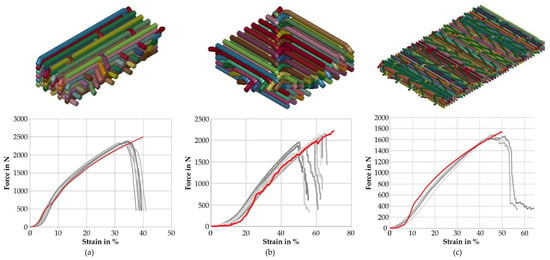
Figure 9.
FEM models and force-strain-curves of selected weaving geometries (grey—experiments, red—simulation), (a) Layer-to-layer satin, (b) Angle-through-thickness, (c) ORW1.
The simulation results of gradient fabrics GW1 and GW2 are shown in Figure 10 and Figure 11. It should be noted that one quarter of the fabrics was simulated and shown in the figures. The displacement in the x-direction (warp yarn direction) is normalized to the maximum displacement and given in %. As can be seen from the displacement of warp yarns during simulation, subregions with graded stiffnesses analogous to the weave zones occurred during deformation of gradient fabrics. Fabric GW1 exhibited the largest displacement in the angle-through-thickness zone, which was the less stiff zone in this gradient fabric (see Figure 10). GW2 was a gradient fabric with angle-through-thickness basic weave and different arrangements of ORW-yarns in the three weave zones. The largest displacement was found in the zone with a larger ORW angle, due to larger ORW yarn offset. Corresponding experimental tests confirmed these results. The additional ORW yarns in GW2 led to inhomogeneous strain behavior of the structures. Comparison of simulated force-strain curves indicated very good agreement with experimental tests of the gradient fabrics in the elastic range (Figure 12).

Figure 10.
Simulation results of gradient fabric GW1: displacement of the warp yarns at different total strain values: (a) 10%, (b) 20%, and (c) 30%.

Figure 11.
Simulation results of gradient fabric GW2: displacement of the warp yarns at different total strain values: (a) 10%, (b) 20%, and (c) 30%.
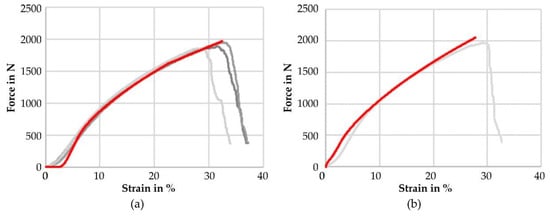
Figure 12.
Experimental (grey) and simulated (red) force-strain curves of (a) GW1 and (b) GW2.
4. Conclusions
The basis for graded, biomimetic and long-term resorbable tendon and ligament implants based on biocompatible silk fibroin yarns was realized. Multilayer woven fabrics from different stiffness levels were developed using simulation and fabricated with silk fibroin yarns. For this purpose, the weaving machine was adapted and meso-scale simulation models were developed and validated. The structural-mechanical behavior simulated with the models of the base fabrics and the gradient fabrics showed very good agreement with experimentally determined data and could, thus, be used for further developments of gradient woven structures. The fabrics were manufactured with a porosity that would allow cell colonization. Therefore, together with the biocompatibility, sterilizability and the slow resorption of silk, such multilayered woven structures have high potential to be applied as tendon or ligament replacement materials. For a medical application of these implants, further research is necessary.
Author Contributions
Conceptualization, T.G., G.H., M.W., D.A. and C.C.; methodology, T.G.L. and D.N.; software, T.G.L.; validation, T.G.L. and D.N.; formal analysis, T.G.L. and D.N.; investigation, T.G.L., D.N. and M.W.; resources, D.N. and M.W.; data curation, T.G.L., D.N. and M.W.; writing—original draft preparation, T.G.L., D.N., T.G.; writing—review and editing, G.H., M.W., D.A., C.C.; visualization, T.G.L., D.N. and T.G.; supervision, T.G., G.H., D.A.; project administration, T.G.L., D.N., M.W. and C.C.; funding acquisition, T.G., M.W., D.A. and C.C. All authors have read and agreed to the published version of the manuscript.
Funding
The IGF research project 20043 BR of the research associations Forschungskuratorium Textil e. V. and Gesellschaft für Chemische Technik und Biotechnologie e. V. (DECHEMA) was funded through the German Federation of Industrial Research Associations (AiF) within the program for supporting the “Industrielle Gemeinschaftsforschung (IGF)” from funds of the Federal Ministry for Economic Affairs and Climate Action (BMWK) by a resolution of the German Bundestag.
Data Availability Statement
Not applicable.
Acknowledgments
The advisory support of the user committee of project IGF 20043 BR is greatly acknowledged. We also thank the project partner Centre for Translational Bone, Joint and Soft Tissue Research of Technische Universität Dresden for the collaboration.
Conflicts of Interest
The authors declare no conflict of interest. The funders had no role in the design of the study; in the collection, analyses, or interpretation of data; in the writing of the manuscript, or in the decision to publish the results.
References
- Kannus, P. Structure of the Tendon Connective Tissue. Scand. J. Med. Sci. Sport. 2000, 10, 312–320. [Google Scholar] [CrossRef]
- Vasconcelos, A.; Gomes, A.C.; Cavaco-Paulo, A. Novel Silk Fibroin/Elastin Wound Dressings. Acta Biomater. 2012, 8, 3049–3060. [Google Scholar] [CrossRef] [Green Version]
- Teuschl, A.H.; Van Griensven, M.; Redl, H. Sericin Removal from Raw Bombyx Mori Silk Scaffolds of High Hierarchical Order. Tissue Eng. Part C Methods 2014, 20, 431–439. [Google Scholar] [CrossRef] [PubMed]
- Fine, N.A.; Lehfeldt, M.; Gross, J.E.; Downey, S.; Kind, G.M.; Duda, G.; Kulber, D.; Horan, R.; Ippolito, J.; Jewell, M.; et al. SERI Surgical Scaffold, Prospective Clinical Trial of a Silk-Derived Biological Scaffold in Two-Stage Breast Reconstruction: 1-Year Data. Plast. Reconstr. Surg. 2015, 135, 339–351. [Google Scholar] [CrossRef]
- Wöltje, M.; Böbel, M. Natural Biodegradable Medical Polymers: Silk. In Science and Principles of Biodegradable and Bioresorbable Medical Polymers; Zhang, X., Ed.; Woodhead Publishing: Duxford, UK, 2017; pp. 351–376. [Google Scholar]
- Wöltje, M.; Kölbel, A.; Aibibu, D.; Cherif, C. A Fast and Reliable Process to Fabricate Regenerated Silk Fibroin Solution from Degummed Silk in 4 Hours. Int. J. Mol. Sci. 2021, 22, 10565. [Google Scholar] [CrossRef] [PubMed]
- Minoura, N.; Aiba, S.; Gotoh, Y.; Tsukada, M.; Imari, Y. Attachment and Growth of Fibroblast Cells on Silk Protein Matrices. J. Biomed. Mater. Res. 1995, 29, 1215–1221. [Google Scholar] [CrossRef]
- Dal Pra, I.; Freddi, G.; Minic, J.; Chiarini, A.; Armato, U. De Novo Engineering of Reticular Connective Tissue In Vivo by Silk Fibroin Nonwoven Materials. Biomaterials 2005, 26, 1987–1999. [Google Scholar] [CrossRef]
- Meinel, L.; Hofmann, S.; Karageorgiou, V.; Kirker-Head, C.; McCool, J.; Gronowicz, G.; Zichner, L.; Langer, R.; Vunjak-Novakovic, G.; Kaplan, D.L. The Inflammatory Responses to Silk Films In Vitro and In Vivo. Biomaterials 2005, 26, 147–155. [Google Scholar] [CrossRef] [PubMed]
- Kim, K.-H.; Jeong, L.; Park, H.-N.; Shin, S.-Y.; Park, W.-H.; Lee, S.-C.; Kim, T.-I.; Park, Y.-J.; Seol, Y.-J.; Lee, Y.-M.; et al. Biological Efficacy of Silk Fibroin Nanofiber Membranes for Guided Bone Regeneration. J. Biotechnol. 2005, 120, 327–339. [Google Scholar] [CrossRef]
- Cai, Z.X.; Mo, X.M.; Zhang, K.H.; Fan, L.P.; Yin, A.L.; He, C.L.; Wang, H.S. Fabrication of Chitosan/Silk Fibroin Composite Nanofibers for Wound-Dressing Applications. Int. J. Mol. Sci. 2010, 11, 3529–3539. [Google Scholar] [CrossRef] [PubMed]
- Liu, T.L.; Miao, J.C.; Sheng, W.H.; Xie, Y.F.; Huang, Q.; Shan, Y.B.; Yang, J.C. Cytocompatibility of Regenerated Silk Fibroin Film: A Medical Biomaterial Applicable to Wound Healing. J. Zhejiang Univ. Sci. B 2010, 11, 10–16. [Google Scholar] [CrossRef] [Green Version]
- Koh, L.D.; Cheng, Y.; Teng, C.P.; Khin, Y.W.; Loh, X.J.; Tee, S.Y.; Low, M.; Ye, E.; Yu, H.D.; Zhang, Y.W.; et al. Structures, Mechanical Properties and Applications of Silk Fibroin Materials. Prog. Polym. Sci. 2015, 46, 86–110. [Google Scholar] [CrossRef]
- Jao, D.; Mou, X.; Hu, X. Tissue Regeneration: A Silk Road. J. Funct. Biomater. 2016, 7, 22. [Google Scholar] [CrossRef]
- Shao, Z.; Vollrath, F. Surprising Strength of Silkworm Silk. Nature 2002, 418, 741. [Google Scholar] [CrossRef]
- Lu, H.H.; Cooper, J.A.; Manuel, S.; Freeman, J.W.; Attawia, M.A.; Ko, F.K.; Laurencin, C.T. Anterior Cruciate Ligament Regeneration Using Braided Biodegradable Scaffolds: In Vitro Optimization Studies. Biomaterials 2005, 26, 4805–4816. [Google Scholar] [CrossRef]
- Anand, S.C.; Kennedy, J.F.; Miraftab, M.; Rajendran, S. (Eds.) Medical Textiles and Biomaterials for Healthcare; Woodhead Publishing: Cambridge, UK, 2006; ISBN 9781855736832. [Google Scholar]
- Freeman, J.W.; Woods, M.D.; Laurencin, C.T. Tissue Engineering of the Anterior Cruciate Ligament Using a Braid-Twist Scaffold Design. J. Biomech. 2007, 40, 2029–2036. [Google Scholar] [CrossRef] [Green Version]
- Machotka, Z.; Scarborough, I.; Duncan, W.; Kumar, S.; Perraton, L. Anterior Cruciate Ligament Repair with LARS (Ligament Advanced Reinforcement System): A Systematic Review. Sport. Med. Arthrosc. Rehabil. Ther. Technol. 2010, 2, 1–10. [Google Scholar] [CrossRef] [Green Version]
- Walters, V.I.; Kwansa, A.L.; Freeman, J.W. Design and Analysis of Braid-Twist Collagen Scaffolds. Connect. Tissue Res. 2012, 53, 255–266. [Google Scholar] [CrossRef]
- Gereke, T.; Döbrich, O.; Aibibu, D.; Nowotny, J.; Cherif, C. Approaches for Process and Structural Finite Element Simulations of Braided Ligament Replacements. J. Ind. Text. 2017, 47, 408–425. [Google Scholar] [CrossRef]
- Mengsteab, P.Y.; Freeman, J.; Barajaa, M.A.; Nair, L.S.; Laurencin, C.T. Ligament Regenerative Engineering: Braiding Scalable and Tunable Bioengineered Ligaments Using a Bench-Top Braiding Machine. Regen. Eng. Transl. Med. 2021, 7, 524–532. [Google Scholar] [CrossRef] [PubMed]
- Sahoo, S.; Ouyang, H.; James, C.H.; Tay, T.E.; Toh, S.L. Characterization of a Novel Polymeric Scaffold for Potential Application in Tendon/Ligament Tissue Engineering. Tissue Eng. 2006, 12, 91–99. [Google Scholar] [CrossRef] [PubMed] [Green Version]
- Sahoo, S.; Cho-Hong, J.G.; Siew-Lok, T. Development of Hybrid Polymer Scaffolds for Potential Applications in Ligament and Tendon Tissue Engineering. Biomed. Mater. 2007, 2, 169–173. [Google Scholar] [CrossRef] [Green Version]
- Zheng, Z.; Ran, J.; Chen, W.; Hu, Y.; Zhu, T.; Chen, X.; Yin, Z.; Heng, B.C.; Feng, G.; Le, H.; et al. Alignment of Collagen Fiber in Knitted Silk Scaffold for Functional Massive Rotator Cuff Repair. Acta Biomater. 2017, 51, 317–329. [Google Scholar] [CrossRef] [Green Version]
- Ge, Z.; Yang, F.; Coh, J.C.H.; Ramakrishna, S.; Lee, E.H. Biomaterials and Scaffolds for Ligament Tissue Engineering. J. Biomed. Mater. Res. Part A 2006, 77, 639–652. [Google Scholar] [CrossRef]
- Pruitt, L.A.; Chakravartula, A.M. Mechanics of Biomaterials—Fundamental Principles for Implant Design; Cambridge University Press: Cambridge, UK, 2011; ISBN 9780511977923. [Google Scholar]
- Peterson, D.; Mattern, R.; Popper, P.; Emmitt, R.; Rizik, S.; Ohashi, K.; Ball, R. Endoprosthetic Textile Scaffold, Especially for Repairing Rotator Cuff Tissue of Human Shoulder. Patent EP 2 387 970 B1, 3 July 2013. [Google Scholar]
- Smith, R.D.J.; Zargar, N.; Brown, C.P.; Nagra, N.S.; Dakin, S.G.; Snelling, S.J.B.; Hakimi, O.; Carr, A. Characterizing the Macro and Micro Mechanical Properties of Scaffolds for Rotator Cuff Repair. J. Shoulder Elb. Surg. 2017, 26, 2038–2046. [Google Scholar] [CrossRef] [PubMed]
- Hoyer, M.; Drechsel, N.; Meyer, M.; Meier, C.; Hinüber, C.; Breier, A.; Hahner, J.; Heinrich, G.; Rentsch, C.; Garbe, L.A.; et al. Embroidered Polymer-Collagen Hybrid Scaffold Variants for Ligament Tissue Engineering. Mater. Sci. Eng. C Mater.Biol. Appl. 2014, 43, 290–299. [Google Scholar] [CrossRef] [PubMed]
- Hahner, J.; Hinüber, C.; Breier, A.; Siebert, T.; Brünig, H.; Heinrich, G. Adjusting the Mechanical Behavior of Embroidered Scaffolds to Lapin Anterior Cruciate Ligaments by Varying the Thread Materials. Text. Res. J. 2015, 85, 1431–1444. [Google Scholar] [CrossRef] [Green Version]
- Blount, A.L.; Armstrong, S.D.; Yuan, F.; Burgess, S.D. Porous Polyurethaneurea (Artelon) Joint Spacer Compared to Trapezium Resection and Ligament Reconstruction. J. Hand Surg. Am. 2013, 38, 1741–1745. [Google Scholar] [CrossRef]
- Petranto, R.D.; Lubin, M.; Floros, R.C.; Pfeiffer, D.A.; Spiess, K.; Lenz, R.; Crowell, A.; Ahmad, H.; Chandrani, S.; Landsman, A.S. Soft Tissue Reconstruction with Artelon for Multiple Foot and Ankle Applications. Clin. Podiatr. Med. Surg. 2018, 35, 331–342. [Google Scholar] [CrossRef]
- Chen, X.; Taylor, L.W.; Tsai, L.-J. An Overview on Fabrication of Three-Dimensional Woven Textile Preforms for Composites. Text. Res. J. 2011, 81, 932–944. [Google Scholar] [CrossRef]
- Hübner, M.; Diestel, O.; Sennewald, C.; Gereke, T.; Cherif, C. Simulation of the Drapability of Textile Temi-Finished Products with Gradient-Drapability Characteristics by Varying the Fabric Weave. FIBRES Text. East. Eur. 2012, 20, 88–93. [Google Scholar]
- Durville, D. Microscopic Approaches for Understanding the Mechanical Behaviour of Reinforcement in Composites. In Composite Reinforcements for Optimum Performance; Boisse, P., Ed.; Woodhead Publishing Limited: Cambridge, UK, 2011; pp. 461–485. ISBN 9781845699659. [Google Scholar]
- El Said, B.; Green, S.; Hallett, S.R. Kinematic Modelling of 3D Woven Fabric Deformation for Structural Scale Features. Compos. Part A Appl. Sci. Manuf. 2014, 57, 95–107. [Google Scholar] [CrossRef] [Green Version]
- Gereke, T.; Cherif, C. A Review of Numerical Models for 3D Woven Composite Reinforcements. Compos. Struct. 2019, 209, 60–66. [Google Scholar] [CrossRef]
- Wang, Y.; Sun, X. Digital-Element Simulation of Textile Processes. Compos. Sci. Technol. 2001, 61, 311–319. [Google Scholar] [CrossRef]
- Zhou, G.; Sun, X.; Wang, Y. Multi-Chain Digital Element Analysis in Textile Mechanics. Compos. Sci. Technol. 2004, 64, 239–244. [Google Scholar] [CrossRef]
- Daelemans, L.; Faes, J.; Allaoui, S.; Hivet, G.; Dierick, M. Finite Element Simulation of the Woven Geometry and Mechanical Behaviour of a 3D Woven Dry Fabric under Tensile and Shear Loading Using the Digital Element Method. Compos. Sci. Technol. 2016, 137, 177–187. [Google Scholar] [CrossRef]
- Döbrich, O.; Gereke, T.; Cherif, C. Modeling the Mechanical Properties of Textile-Reinforced Composites with a near Micro-Scale Approach. Compos. Struct. 2016, 135, 1–7. [Google Scholar] [CrossRef]
- DIN EN ISO 2062; Textiles—Yarns from Packages—Determination of Single-End Breaking Force and Elongation at Break Using Constant Rate of Extension (CRE) Tester. DIN Deutsches Institut für Normung e. V.: Berlin, Germany, 2010.
- DIN EN ISO 13934-1; Textiles—Tensile Properties of Fabrics—Part 1: Determination of Maximum Force and Elongation at Maximum Force Using the Strip Method. DIN Deutsches Institut für Normung e. V.: Berlin, Germany, 2013.
- Brown, L.P.; Long, A.C. Modelling the Geometry of Textile Reinforcements for Composites: TexGen. In Composite Reinforcements for Optimum Performance; Boisse, P., Ed.; Woodhead Publishing Limited: Oxford, UK, 2011; pp. 239–264. [Google Scholar]
Publisher’s Note: MDPI stays neutral with regard to jurisdictional claims in published maps and institutional affiliations. |
© 2022 by the authors. Licensee MDPI, Basel, Switzerland. This article is an open access article distributed under the terms and conditions of the Creative Commons Attribution (CC BY) license (https://creativecommons.org/licenses/by/4.0/).
